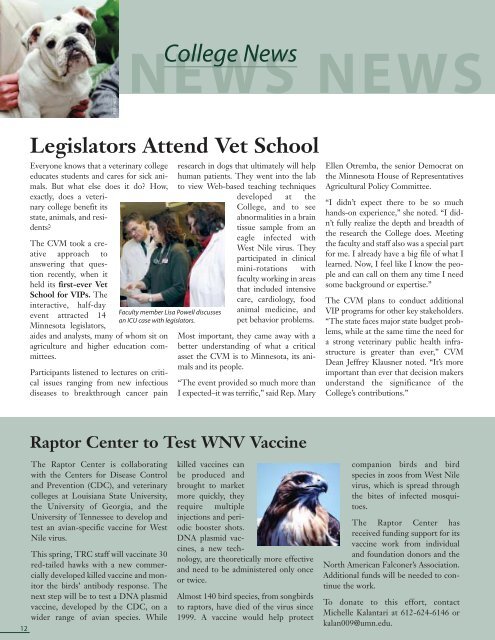Spring 2003 - University of Minnesota College of Veterinary Medicine
Spring 2003 - University of Minnesota College of Veterinary Medicine
Spring 2003 - University of Minnesota College of Veterinary Medicine
- No tags were found...
You also want an ePaper? Increase the reach of your titles
YUMPU automatically turns print PDFs into web optimized ePapers that Google loves.
NEWS<br />
<strong>College</strong> News<br />
NEWS<br />
FILE PHOTO<br />
Legislators Attend Vet School<br />
Everyone knows that a veterinary college<br />
educates students and cares for sick animals.<br />
But what else does it do How,<br />
exactly, does a veterinary<br />
college benefit its<br />
state, animals, and residents<br />
The CVM took a creative<br />
approach to<br />
answering that question<br />
recently, when it<br />
held its first-ever Vet<br />
School for VIPs. The<br />
interactive, half-day<br />
Faculty member Lisa Powell discusses<br />
an ICU case with legislators.<br />
event attracted 14<br />
<strong>Minnesota</strong> legislators,<br />
aides and analysts, many <strong>of</strong> whom sit on<br />
agriculture and higher education committees.<br />
Participants listened to lectures on critical<br />
issues ranging from new infectious<br />
diseases to breakthrough cancer pain<br />
research in dogs that ultimately will help<br />
human patients. They went into the lab<br />
to view Web-based teaching techniques<br />
developed at the<br />
<strong>College</strong>, and to see<br />
abnormalities in a brain<br />
tissue sample from an<br />
eagle infected with<br />
West Nile virus. They<br />
participated in clinical<br />
mini-rotations with<br />
faculty working in areas<br />
that included intensive<br />
care, cardiology, food<br />
animal medicine, and<br />
pet behavior problems.<br />
Most important, they came away with a<br />
better understanding <strong>of</strong> what a critical<br />
asset the CVM is to <strong>Minnesota</strong>, its animals<br />
and its people.<br />
“The event provided so much more than<br />
I expected–it was terrific,” said Rep. Mary<br />
Ellen Otremba, the senior Democrat on<br />
the <strong>Minnesota</strong> House <strong>of</strong> Representatives<br />
Agricultural Policy Committee.<br />
“I didn’t expect there to be so much<br />
hands-on experience,” she noted. “I didn’t<br />
fully realize the depth and breadth <strong>of</strong><br />
the research the <strong>College</strong> does. Meeting<br />
the faculty and staff also was a special part<br />
for me. I already have a big file <strong>of</strong> what I<br />
learned. Now, I feel like I know the people<br />
and can call on them any time I need<br />
some background or expertise.”<br />
The CVM plans to conduct additional<br />
VIP programs for other key stakeholders.<br />
“The state faces major state budget problems,<br />
while at the same time the need for<br />
a strong veterinary public health infrastructure<br />
is greater than ever,” CVM<br />
Dean Jeffrey Klausner noted. “It’s more<br />
important than ever that decision makers<br />
understand the significance <strong>of</strong> the<br />
<strong>College</strong>’s contributions.”<br />
Raptor Center to Test WNV Vaccine<br />
12<br />
The Raptor Center is collaborating<br />
with the Centers for Disease Control<br />
and Prevention (CDC), and veterinary<br />
colleges at Louisiana State <strong>University</strong>,<br />
the <strong>University</strong> <strong>of</strong> Georgia, and the<br />
<strong>University</strong> <strong>of</strong> Tennessee to develop and<br />
test an avian-specific vaccine for West<br />
Nile virus.<br />
This spring, TRC staff will vaccinate 30<br />
red-tailed hawks with a new commercially<br />
developed killed vaccine and monitor<br />
the birds’ antibody response. The<br />
next step will be to test a DNA plasmid<br />
vaccine, developed by the CDC, on a<br />
wider range <strong>of</strong> avian species. While<br />
killed vaccines can<br />
be produced and<br />
brought to market<br />
more quickly, they<br />
require multiple<br />
injections and periodic<br />
booster shots.<br />
DNA plasmid vaccines,<br />
a new technology,<br />
are theoretically more effective<br />
and need to be administered only once<br />
or twice.<br />
Almost 140 bird species, from songbirds<br />
to raptors, have died <strong>of</strong> the virus since<br />
1999. A vaccine would help protect<br />
companion birds and bird<br />
species in zoos from West Nile<br />
virus, which is spread through<br />
the bites <strong>of</strong> infected mosquitoes.<br />
The Raptor Center has<br />
received funding support for its<br />
vaccine work from individual<br />
and foundation donors and the<br />
North American Falconer’s Association.<br />
Additional funds will be needed to continue<br />
the work.<br />
To donate to this effort, contact<br />
Michelle Kalantari at 612-624-6146 or<br />
kalan009@umn.edu.

















